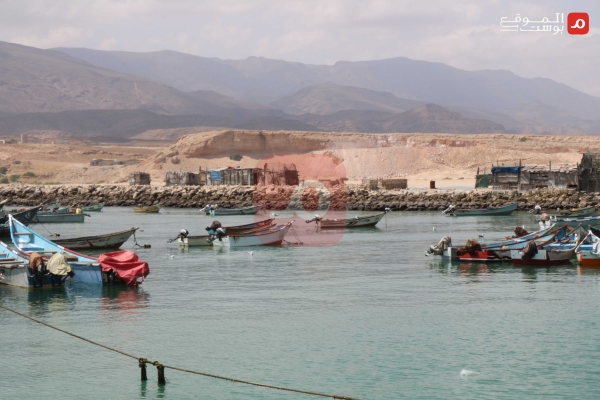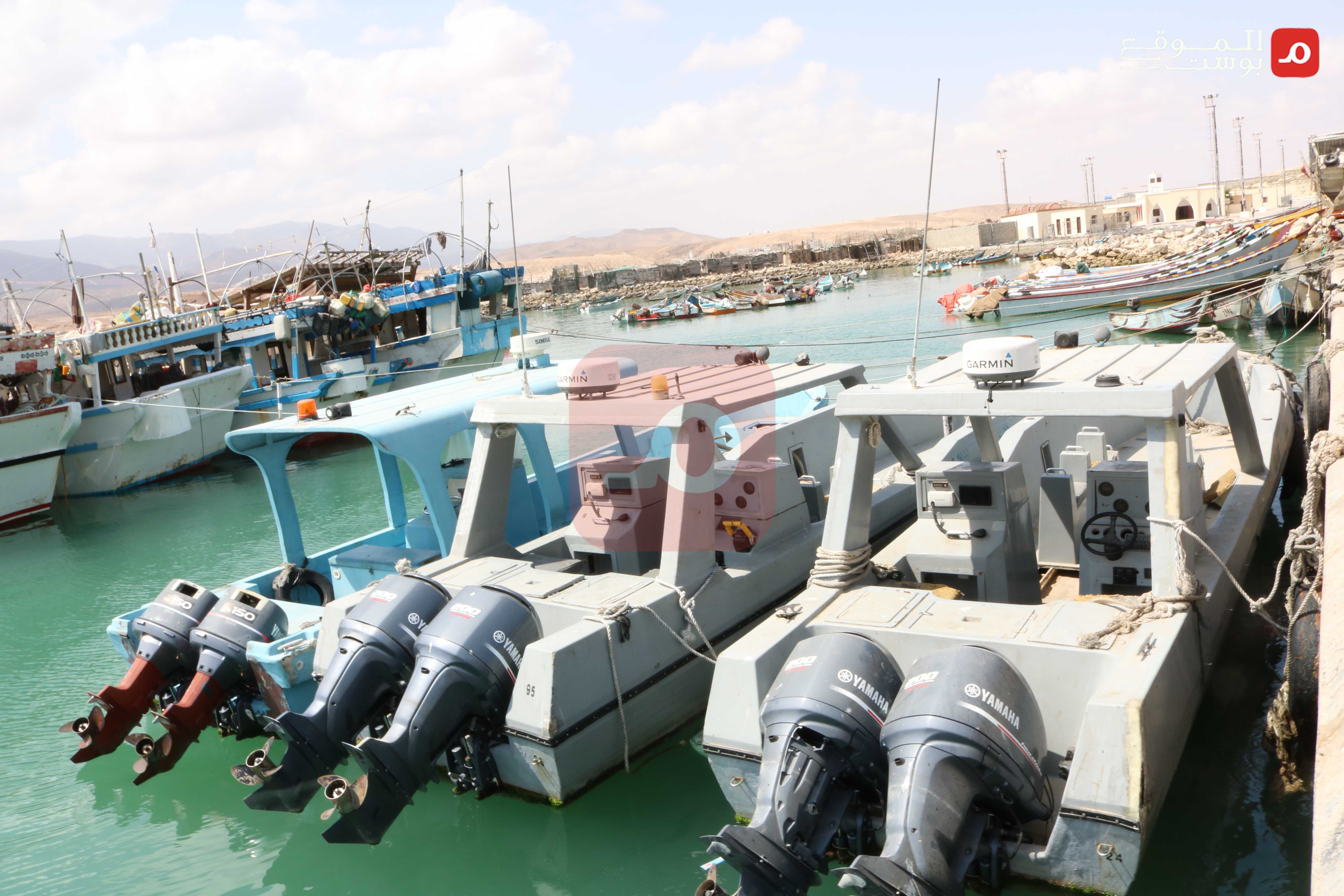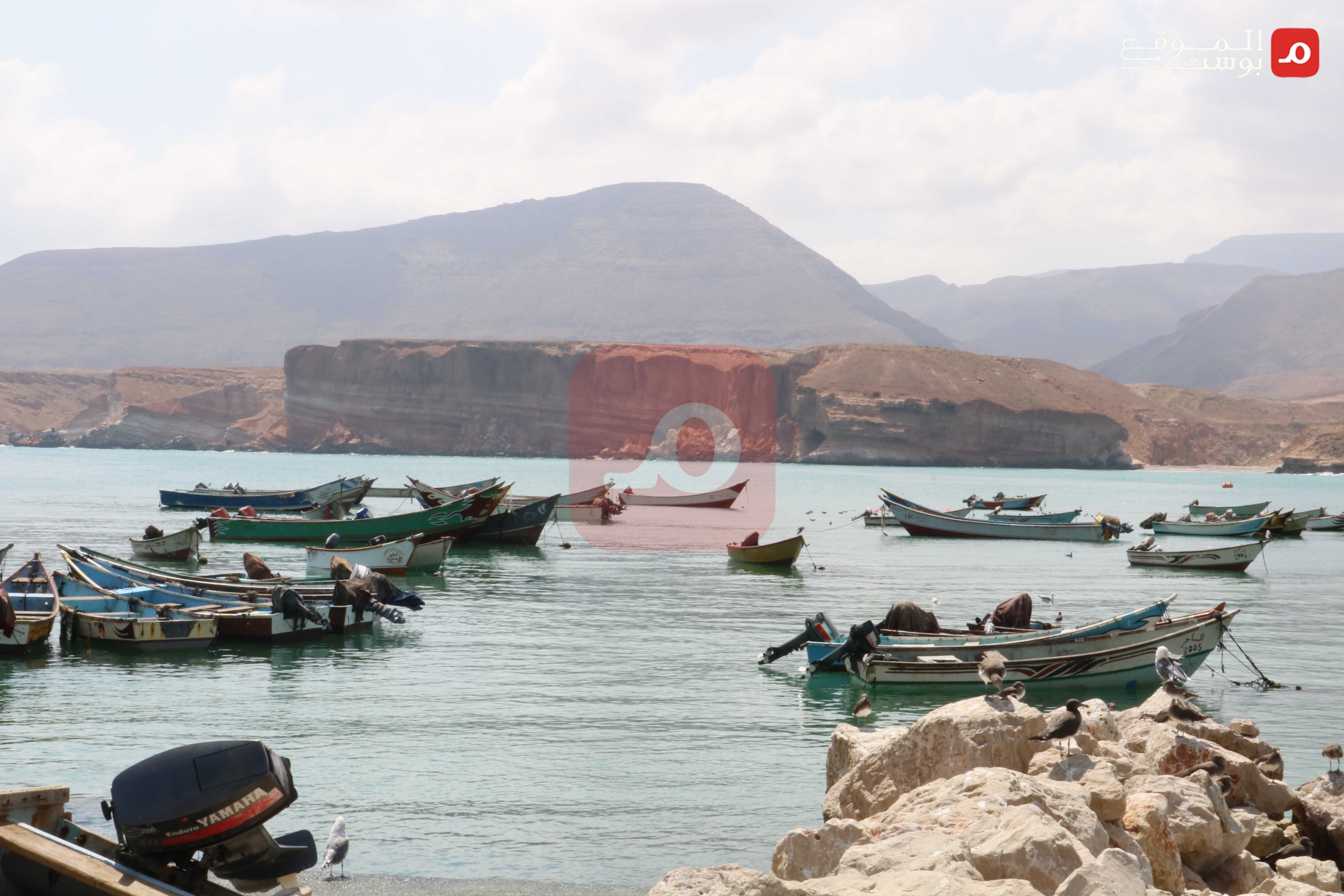
[ Nishtun: From Yemeni Commercial Port to Military Barracks for Saudi Arabia ]
If you have commercial goods you wish to import into Yemen through the Port of Nishtun in the Governorate of Mahra (eastern Yemen) you must first apply to the Saudi-led Arab Coalition for advance authorization. Otherwise, you would not be able to do anything.
If you were ever to visit the Port of Nishtun, the Saudi forces in Mahra will be the first to know of your visit. If you, for some reason, are an unwelcome person to these forces then there is a very real possibility that you will be arrested and detained in the prison established by these forces inside the Ghayda Airport.
The Port of Nishtun is located on the eastern front of the Yemeni Republic, west of the District of Ghayda, the capital and prime district of the Governorate of Mahra. It is the only port in it. It was inaugurated in 1984. It is 210 meters long and 5 meters deep. It was established as a multi-purpose port to serve the commercial and fishing activity. It was rehabilitated in 2010.
It is characterized by its commercial activity between the Gulf states and the Governorate of Mahra which decreased in years past due to the inauguration of the landlocked road between Yemen and the Gulf states. Following the drippling of the majority of Yemeni ports and the shutdown of most international landlocked crossings because of the war experienced by Yemen since 2015, it started to regain momentum.
But the situation did not last long. The Arab Coalition’s control of the Governorate of Mahra impacted the port, transforming it from a commercial port to military barracks, and shifting it from under the oversight of the legitimate Yemeni Government to the full supervision of the Arab Coalition states led by the Kingdom of Saudi Arabia.
Nishtun Geography
The road leading to the Port of Nishtun from the city of Ghayda passes through an asphalt line whose length is estimated at 45 kilometers. It also goes through mountainous heights, desert expanses and seacoast beaches.
The port consists of two docks: the first commercial and the second dedicated to fishermen.It is anestuary located in an open area between mountain and plain, over an estimated area of 4 square kilometers. In the background is land in which imported cars have collected, many of which have depreciated. On its right is a small village inhabited by citizens from the area. It also includes a market on the road crossing the port site and leading to Hadhramaut as an international coastal road.
The port is administratively part of the Yemen Arabian Sea Port Corporation(YASPC) which was created by virtue of Presidential Decision Number (62) of 2007 and operates under the Maritime Affairs Authority (MAA). It is locally overseen by the local authority of the Governorate of Mahra. Its activity is regulated by the Yemeni Ministry of Transport which operates from the temporary capital of Aden.
Importance of the Port
The Port of Nishtun is vitally important, whether in terms of geography and its closeness to the Gulf states, especially Oman, or in terms of the financial revenues it generates every day and which constitute a source of national income for the Yemeni Republic in general and the Governorate of Mahra in particular, especially at present. Most of its revenue goes to the governorate, with a fraction channeled to YASPC which is headquartered in the Governorate of Hadhramaut.

Inside the Port of Nishtun are large tanks used to store oil by-products that arrive in the Governorate of Mahra and are distributed to the fuel stations or are used by public institutions.
The port used to operate as a multi-purpose port. Cars, trucks and various goods arrived in the port from several countries, mostly from Gulf States, e.g. the Port of Dubai in the UAE and the Port ofSalalah in Oman. It recently changed from an importer of all types of goods to a port dedicated to the sole import of oil by-products in line with the measures created by more than one mechanism lately.
There is, at the port, a governmental team from the different government institutions to manage the site, e.g. Transport and Customs, in addition to the security forces tasked there, e.g. Political, National and General Security. Then there are the forces of the Yemeni Army which handle the guarding of the port and are part of Brigade 137 Infantry. When the Saudi forces arrived they imposed their hegemony over everyone there.
Its importance also lies in the availability of a wide area for fishing, which is the occupation practiced by a large sector of the people of Mahra. This activity is regulated by the Nishtun Fishermen Association, headed by a man called “Sheikh of the Fishermen.” These people have recently faced harassments like the rest of the fishermen of Mahra. We will address their suffering in an independent exposé which will be published later.
General Situation in the City
The remarkable fact here is that the port, despite generating revenue and being considerably important, the port and the residential areas near and around it are plagued by power cuts all day and the power is only on at night. The residents there also complain of the absence of a project to supply water to households. This situation is strange compared to the other districts of the governorate, despite the fact that the port is commercial and generates millions for the governorate.

According to residents interviewed by Al-Mawqea Post, the entire city of Nishtun lacks a fully equipped medical dispensary to offer the health services needed by the inhabitants. In emergencies, the patients are taken to the city of Ghayda, which has hospitals of poor capacity, or to the city of Mukalla in Hadhramaut. Critical cases are taken to the Omani city of Salalah whose authorities offer all the necessary medical facilities for the residents of the city of Nishtun and all the districts of the Governorate of Mahra.
Outset of Foreign Hegemony
With the deteriorating political situation in Yemen, and the outbreak of the Arab Coalition-led war four years ago, the port sustained neglect and became separate, in terms of financial revenues, from the center in the capital Sanaa. But it maintained a modicum of survival and operation. Then came the comprehensive siege of the ports and crossings, imposed by the Arab Coalition at the request of the Yemeni Government. The port became subject, in its operating mechanism to the Arab Coalition, and official governmental supervision from the Yemeni camp remained nominal.
It was taken over by UAE forces when they arrived in the Governorate of Mahra in 2015 but they did not exercise any real authority over the port due to their short-lived presence there, and their failure to establish a local military force loyal to them, as happened in the governorates of Aden, Shabwa and Hadhramaut.

When the Emiratis left the Governorate of Mahra, they were replaced by the Saudi forces which arrived in the governorate in November 2017 and gradually extended their presence so that their control covered all landlocked and marine ports in Mahra. The Port of Nishtun had the biggest share of that presence, which ended in hegemony and full control by the Saudi forces.
Nishtun as a Strategic Goal for Saudi Arabia
The Port of Nishtun represents a decades-long strategic goal for KSA, reflecting its aspiration to open a port for itself on the Arabian Sea to transport oil through pipelines from Saudi fields to the global market, without resorting to the Strait of Hormuz, by which a landlocked project is established, leading from inside Saudi territories and ending at the Port of Nishtun.
The Saudi Government has striven to implement this strategy for a long time now. Recently circulated Saudi documents show Riyadh’s aspiration to carry out this project since the early 1980s. Saudi Arabia’s naturalization campaigns that targeted the Mahra tribes were a prelude, as confirmed by the tribal sheikhs interviewed by Al-Mawqea Post.
The Saudi Government sought to implement the project during the rule of former President Ali Abdullah Saleh. But these steps ran aground after Saudi Arabia insisted to impose its own terms and rejected the proposition made by former President Saleh.
Leading tribal sheikh in the Governorate of Mahra Ali Salem al-Hureizi observed that an official delegation from the Saudi Government visited former President Saleh and met with him in the capital city of Sanaa in 2002 to agree on installing the pipeline in the Governorate of Mahra, but the meeting ended in failure.

Al-Hureizi explained that Saleh summoned and informed him that Saudi Arabia wanted to install a 300-kilometer pipeline through Mahra, pumping 500,000 barrels per day, and will establish an asphalt road running parallel to the pipeline over a distance of 2-4 kilometers on both sides of the road. The road would be under its full sovereignty, and would be protected by the Saudi army and security, without any interference by the Yemeni camp. Bridges would be built along the road for Yemenis so as not to pass through the road installed by Saudi Arabia.
In his conversation with Al-Mawqea Post, Al-Hureizi added that President Saleh proposed giving the Saudis a city on the Arabian Sea to accommodate staff, tanks and maintenance, specifying a purely Yemeni force to handle the guarding of the port, and working with the Ministry of Foreign Affairs to identify the Yemeni and Saudi staff and maintenance teams.
According to Al-Hureizi, Saleh also expressed willingness to create a brigade of Mahra locals to handle guarding duties under the supervision of the Yemeni Army, and coordinate in terms of Saudi security too. But the Saudis refused Saleh’s proposition. Their condition was for the forces to be fully Saudi. Then the whole thing ground to a halt.
After that date, Saudi Arabia’s talk of implementing this project faded. Following their launch of the military campaign in Yemen, dubbedOperation Decisive Storm, Saudi Arabia resumed working on achieving the dream, as revealed seven months after the war broke out, with the Salman Canal Project.
In early September 2015, the Head of Alqarn Al ArabiResearch and Studies Center (ACCSU)in Riyadh, Saad bin Omar, published a study entitled The Salman Canal, in reference to Saudi King Salman bin Abdul Aziz. It consisted of a comprehensive study to connect the Arabian Gulf by sea with the Arabian Sea through a marine canal, after changing the name it held – the Arabian Canal – to the Salman Canal.

According to the Saudi media which touched on the study, the canal will be 950 kilometers long and run for 630 kilometers through Saudi soil and 320 kilometers through Yemeni soil. The canal will be 150 meters wide and 25 meters deep.
Based on this project, the gains that the canal will generate for Saudi Arabia exceed those produced for Yemen. Its officers say that it will help reanimate the Rub’ al Khali by creating hotels and tourist resorts on the canal banks. It will also allow Saudi Arabian self-sufficiency in fish resources by building fisheries alongside it and creating lakes connected to the canal for this purpose, not to mention energy projects, water desalination projects and the construction of multiple residential cities. It will moreover supply an additional 1,200 kilometers of clean and beautiful shores to the Rub’ al Khali area for KSA.
The Saudi camp will build 20 tunnels for vehicles and pedestrians. Three residential cities and two industrial cities are planned, as well as multiple lakes on both sides of the canal for fisheries and ship maintenance.
As for the Yemenis, according to the Head of ACCSU, it will create at least a million job opportunities throughout the construction of the project. It will supply Yemen with more than 700 kilometers of additional coasts on which cities and resorts will be built.
The overall cost of this canal is estimated at 80 billion dollars. An independent authority will be created by the two countries to build and operate it, with a joint capital, while maintaining the sovereignty of the countries. The Saudi official stated at the time that many Saudi firms had almost completed the projects assigned to them, and possess equipment and trained labor capable of undertaking construction and excavation. He estimated the completion of all works within five years.
The main difficulty facing the project, when it was revealed, was the political instability in Yemen. Therefore, an alternative course was established for the canal so that it would end on one of Oman’s shores instead of in Yemen